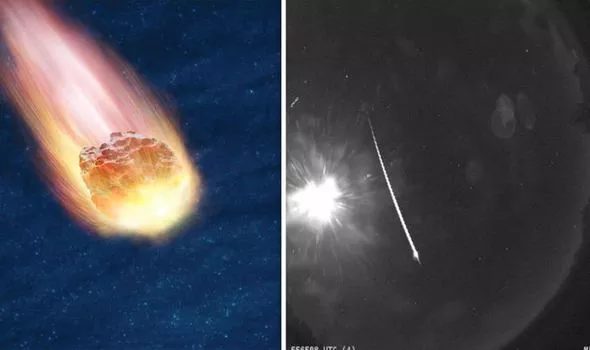
Meteor shock: NASA footage shows huge explosion in skies above Arizona
The video showed a fireball travelling at more than 200,000 kilometres per hour light up the night sky over Arizona yesterday. The space rock was part of the relatively newly-discovered meteor shower, the October Ursae Majorids, which was only deemed separate from the usual October Orionid and Taurid meteors in 2007. NASA said the small object was travelling at a staggering 57.2 kilometres per second - or 205,920 km per hour - when it crashed into and exploded in Earth's upper atmosphere.
The NASA video showed the object streaking across the night's sky before producing a flash which outshone the Moon.
NASA has traced the meteor back to the Big Dipper constellation, which allowed the space agency to confidently state it is part of the October Ursae Majorids shower.
The meteor shower peaks during mid-October, and on clear nights one fireball can be seen per hour on average.
No debris from the meteor has yet been discovered on the ground.
Meteors produce a bright explosion of fire when they hit the atmosphere as it is the first time the space rock has ever met resistance.
Air seeps into the pours and cracks of the rock, pushing it apart and causing it to explode.
The International Meteor Organization said: "Fireballs are meteors that appear brighter than normal.
"Due to the velocity at which they strike the Earth's atmosphere, fragments larger than 1 millimetre have the capability to produce a bright flash as they streak through the heavens above.
"These bright meteors are what we call fireballs and they often strike fear and awe for those who witness them."
While this meteor was small, the bright flash reiterates the need for eyes on the skies to watch out for potential asteroid collisions.
While the chances of a major asteroid hitting Earth are small - NASA believes there is a one in 300,000 chance every year that a space rock which could cause regional damage will hit - the devastating prospect is not impossible.
However, there are some plans on the go which could help Earth against potential asteroid strikes.
NASA is currently studying Asteroid Bennu, where its OSIRIS-Rex spacecraft arrived last year.
Part of the reason NASA is sending the OSIRIS-Rex spacecraft there is to gather more information about the space rock which is 500 metres in length.
NASA fears that the asteroid, which has the potential to wipe out a country on Earth, could hit our planet within the next 120 years, with the next close flyby in 2135.
The mission will give vital information on how to deflect asteroids from their collision course with Earth, but NASA reiterates that while there is a small chance Earth could be impacted, "over millions of years, of all of the planets, Bennu is most likely to hit Venus."
Most /(all) folks around looked at me - the nut pointing to the S at about 35 degrees above horizon as it passed from SSE at 40 degrees to SSW at 30 degree, By the time any looked, it was gone. BEAUTIFUL!
R.C.